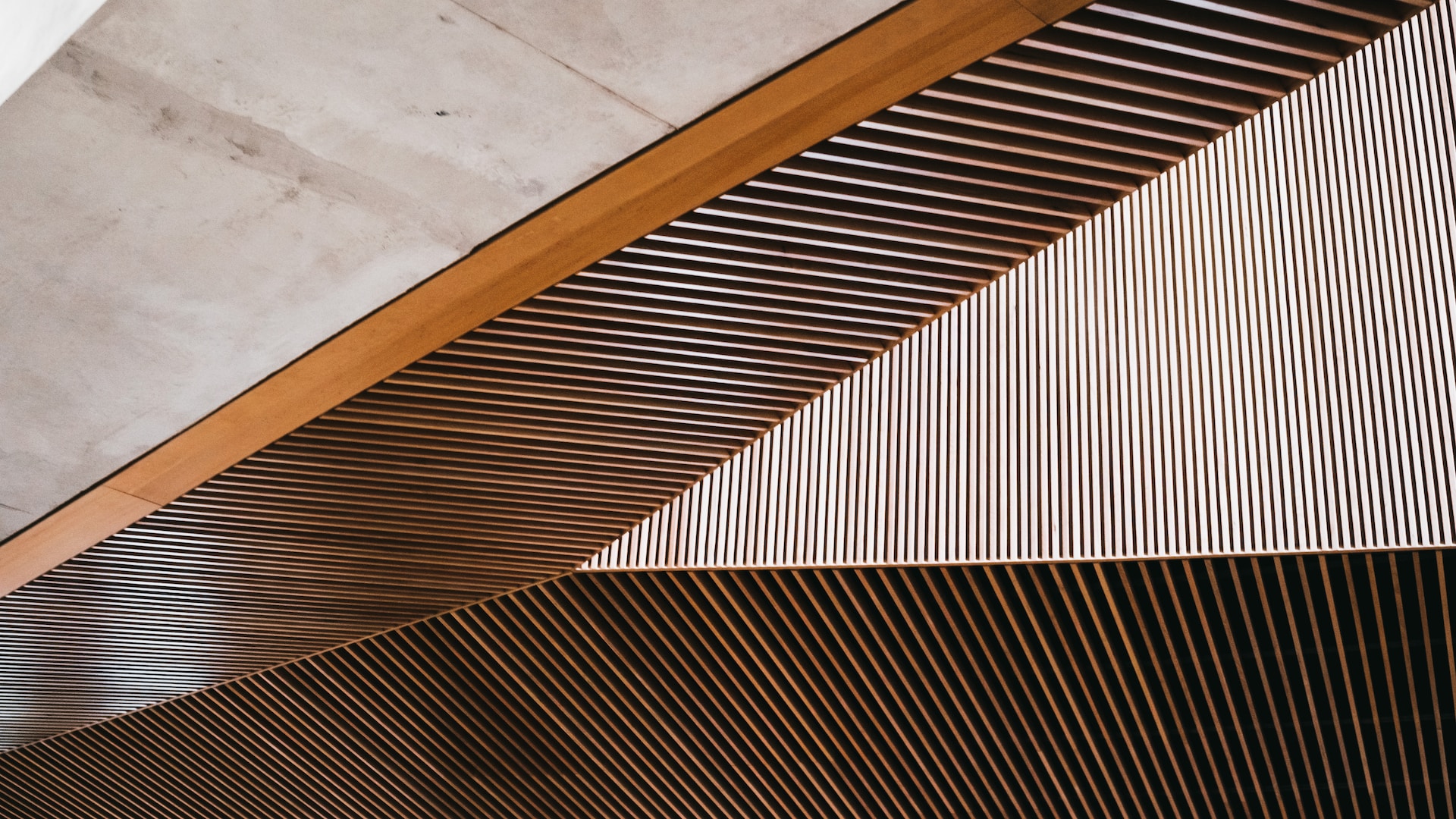
When it comes to ceiling materials, wood has always been a popular choice. It’s natural, improves acoustic performance, and looks great. There are a lot of wonderful reasons people choose wood ceilings for both residential and commercial projects.
If you’re new to the world of wood ceilings, you may feel overwhelmed by your options. There are so many great ways to utilize wood in your ceiling design that you should educate yourself first. Understanding the different styles and their benefits goes a long way in making a sound decision. We’ll cover some different types of wood ceilings and the benefits they provide. We’ll even touch on some potential downsides. But to get started, let’s look at the reasons we choose wood ceilings at all.
Why Wood Ceilings?
When it comes to wood ceilings, benefits are plenty. Some benefits are universal, while others are inherent to one style or another. To simplify, let’s start by looking at benefits that go along with all types of wood ceilings. These benefits come from the fact that wood is a natural, calming material in decor. They also have to do with the composition of wood as a building material.
Wood Looks Great
The first consideration we usually gravitate toward in any design project is the way a material looks. Wood is a classic building material, and each plank or panel has its own character. The unique grain patterns of each individual cut deliver a world of visual interest in wood ceilings.
You can also get nearly any species on the planet these days. The global supply chain has connected us in ways that make the previously unattainable fairly affordable. Even if solid wood is still prohibitively expensive, veneers can allow us to obtain all the species we love.
Wood veneer is created by taking very thin slices of wood and affixing them to a backing material. The backer may be chipboard, fiberboard, or some other material, but it’s always more affordable than solid wood. You’ll only see the veneer, so no one will know what’s behind your beautiful facade.
Whether you choose one species over another or veneer over solid wood, you’ll gain the benefit of using natural materials.
Natural Materials Are Calming
When we decorate interior spaces with natural materials, it has a notable impact on our mental wellbeing. Something about being surrounded by nature calms us and reduces anxiety. Anyone who has ever taken a walk in the woods knows this firsthand. Since the EPA estimates that the average American spends roughly 90% of their life indoors, bringing nature indoors makes sense.
Balancing interior decor with natural elements can take the edge off in an increasingly complicated world. Incorporating other earth elements, such as fire, water, and metal, enhances this calming effect. But the most attractive and practical option for our ceilings is wood.
Wood Is a Great Acoustic Material
Another thing we need to be cognizant of when designing indoor spaces is acoustics. Our walls, floors, and ceilings are usually made of hard, smooth surfaces. These types of surfaces are not ideal in the world of acoustics. Sound waves bounce off them in straight lines, creating audio issues like echo and reverberation. The way to solve this is to incorporate softer, more porous materials. Wood ceilings are a great way to achieve better acoustics in your home or office.
Wood may be hard, but it is fairly porous when compared to other options. That means some of the sound waves that impact it will be absorbed. When sound waves encounter porous surfaces, some of the sound enters and becomes trapped. This prevention of direct reflections makes spaces sound better because sound isn’t reflecting endlessly. We can accomplish greater sound absorption with acoustic panels and furniture with absorbent upholstery, but wood ceilings take sound quality to another level.
Popular Types of Wood Ceilings
Now that we’ve covered some of the basic benefits of wood ceilings, let’s look at some popular styles. Each offers something a little different than the others and will impact your design in unique ways. The style you choose will affect both the look and acoustic performance of your wood ceiling.
Wood Panels
Wood panels are the first style we will cover, not only because of their popularity in interior decor, but because they’re easy to install yourself. Going with this style will provide you with a look you love at a price that won’t break the bank.
Wood panels are prefabricated panels made of solid wood or wood veneer. They are typically suspended from the ceiling in a grid system. The grid is suspended from the ceiling by cables, and the panels are laid into it.
With a few basic tools, you can install this type of wood ceiling yourself. If you want to do any overhead work, just pop a panel out, do the work, and drop it back in. No need to patch holes or match textures.
If you go with a thick frame with deep-set panels, you can even create a coffered ceiling look that works wonders for your acoustics. It’ll help keep sound from traveling and allow you to converse in groups without shouting or straining. That makes these panels especially good as commercial wood ceiling systems or in places where people gather and converse.
Clouds
If you’d prefer to suspend the panels without the grid system, consider a cloud ceiling. In this configuration, the panels are suspended themselves. That leaves empty space where the grid would be. Not only does this add depth to the surface, but it also allows us to get creative with the interior design.
If you want to add some backlighting to the panels, that’s possible. If you want to drop lighting fixtures through the field of panels, you can do that too. There are seemingly endless ways to accent this ceiling type for creative results.
Microperforated Panels
If you want to get the best acoustic performance out of your panels, consider microperforated wood panels. These panels are pierced with thousands of tiny, nearly invisible holes that give them superior acoustical performance. Here’s why:
When sound waves encounter microperforated panels, a decent percentage of that sound is allowed to pass through those tiny holes. Once waves have entered, many of them reflect above the ceiling surface and don’t return to the room. That provides a good amount of sound control. If you want to up the ante, add an acoustical backer.
Acoustical backers are made of dense, porous materials like those found in acoustical panels. They’ll trap a lot of the sound as it passes through and catch it on the other side if it reflects overhead. This not only helps to absorb room noise, but it also traps any sounds emanating from overhead pipes or vents.
Wood Planks
Wood planks are another style that really delivers on the aesthetic front. They provide some texture, make the room look longer, and can be finished to produce eye-popping results. They are also easy to mount directly to your current ceiling, making them ideal for rooms with low ceilings.
Planks don’t provide the same acoustic benefits as the panels we’ve covered, but they do deliver some. They are still made of wood and deliver the natural acoustic benefits that go along with all wood ceilings.
Wood Baffles
If you’re going for something more modern, wood baffles are a great option. They are typically constructed of parallel planks laid on their narrower edges and held together with dowels. That structure is then suspended from the ceiling to create a false ceiling with great visual appeal. This is an incredibly popular option in commercial wood ceilings.
Wood baffles help diffuse sound and can be combined with acoustical backers, making them sound acoustic choices. You can even suspend lighting fixtures through them, delivering light exactly where you want it. If you’re looking for something that adds serious visual length to the room, this may be the ticket.
Downsides to Wood Ceilings
With all these benefits, you may be surprised to learn that there are cons of wooden ceilings in some circumstances. First, wood is susceptible to water damage and can warp, crack, or rot if exposed to too much moisture.
Fire is another potential danger. Some buildings require materials to be incredibly fire resistant, making wood a potential no-go for your facade. This is especially true in multi-story or multi-family housing, where fire spread could be catastrophic.
Additionally, wood is the food of choice for a number of common pests. Since wood is an organic material, some insects and animals will use your wood ceilings as food or nest-making materials.
Are Wood Ceilings a Good Idea?
Now that we’ve covered some wooden ceiling advantages and disadvantages, let’s find out whether or not they’re right for you. The easiest way to accomplish this is to reach out to your local wood ceilings pros.
We’re familiar with all the options out there and can help point you in the right direction. We know what works and what doesn’t in different spaces. We’ve also got the materials and expertise to deliver the results you want. Plus, we can do it all on budget.
If you’re ready to start exploring your options, schedule a consultation. You’ll likely learn a lot and set yourself up for success when you’re ready to pull the trigger.




